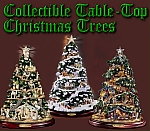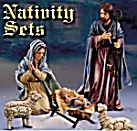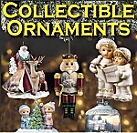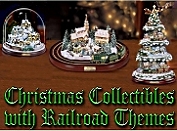

|
What is a Glitter House?
 Many baby boomers remember their family building little communities around their nativity, Christmas tree, or train set at the holidays. Quite a few remember including inexpensive, glitter-sprinkled buildings made of pasteboard and imported from Japan. Many baby boomers remember their family building little communities around their nativity, Christmas tree, or train set at the holidays. Quite a few remember including inexpensive, glitter-sprinkled buildings made of pasteboard and imported from Japan.
Our family had at least two very small sets that were probably postwar, but apparently the best sets were made in the 1930s. I actually haven't thought about them for decades. Then I was contacted by Howard Lamey, a fellow who builds these little houses as a hobby. Howard put me in touch with some prominent collectors, and I began to realize that the glitterhouses were far more widespread and more important to mid-20th-century Christmas celebrations than I had thought.
The First "Christmas Villages"
Between 1910 and 1960, many familes set houses, scenery, and other accessories around their train sets, Nativity displays, and/or Christmas trees. These displays paid little attention to scale, or time period - it wouldn't have been unusual to see the Wise Men crossing in front of a Lionel station, for example. And, in many homes, the display took up the whole room (often a parlor). They've been called "Christmas Gardens," "Train Gardens," and other things, but the strangest name I've heard for them is "putz."
It turns out that many German-Americans used the term "putz" the way we might use the term "putter." As in "Are you going to quit putzing around with those light strands and decorate the tree already?" During Christmas, many families "putzed" around with the Nativity display and the makeshift community around it right up until Christmas day. So the Nativity and anything set up around it came to be called the "putz." In families without a Nativity display, the putz might be set up around the train set or the Christmas tree. (Because, the term "putz" is derogative in some cultures, I try not to use it until I make sure people know what I'm talking about.)
 What is a Putz House? What is a Putz House?
The Christmas Garden/Train Garden/Putz tradition was probably well in place before Japanese paste-board houses arrived in this country. But they caught on immediately.
According to one collector, Ted Althof, cardboard houses made to be filled with candy were around in the early 1900s. But the "breakthrough" came when Japanese-made pasteboard houses started coming with colored celophane windows and a hole in the back for electric Christmas tree lights, which were just becoming available to most families. This breakthrough may have occurred in the mid-1920s. But the earliest definite catalog listing Ted can find of such a set comes from 1928.
At first there was no glitter to speak of - evidently it took the cardboard houses a few years to evolve into the glitter-covered buildings most of us remember today. Ted has catalogued an amazing variety of these things and attempted to narrow down which kinds were made in which years. So, when you visit his site (the link is listed below), be certain to check his history pages.
 On that note, I have noticed that some of these structures had flat roofs with "parapets." I suspect that the designers thought they were imitating Bethlehem architecture to attract nativity-minded customers. On the other hand, Ted has found a line or two that look like they were made specifically to go with toy trains. So it's possible that the designers had both nativity-users and train-users in mind. Either way, the putz soon took on a "life of its own" in many homes. On that note, I have noticed that some of these structures had flat roofs with "parapets." I suspect that the designers thought they were imitating Bethlehem architecture to attract nativity-minded customers. On the other hand, Ted has found a line or two that look like they were made specifically to go with toy trains. So it's possible that the designers had both nativity-users and train-users in mind. Either way, the putz soon took on a "life of its own" in many homes.
Where Did They Come From, Anyway?
 Ted has also tried, unsuccessfully, to find out who was designing all of these wonderful structures in pre-war Japan. He did learn that the factories were very cruel places to work, a sad, ironic, footnote to this history. But if you know anything about the Japanese designers, please contact me or Ted and help us give credit where credit is due. Ted has also tried, unsuccessfully, to find out who was designing all of these wonderful structures in pre-war Japan. He did learn that the factories were very cruel places to work, a sad, ironic, footnote to this history. But if you know anything about the Japanese designers, please contact me or Ted and help us give credit where credit is due.
Glitterhouses Today
Putz houses are becoming recognized collectibles (some of the unique buildings are in high demand). One person with a unique collection is author Antoinette Stockenberg, whose link is below.
In addition, several folks besides my friend Howard Lamey are building replicas for families and friends. They have experimented with modern materials to find out what materials best give the "look and feel" of the originals; yet each creation is unique. (Some of the buildings Howard has built are shown in the title photo - click on it for a "blow-up")
Conclusion
If you have photos of your glitterhouse collections or projects that you would like to share with our readers, please contact us, and pass along as much information about your houses as you can. We'll be sure to give credit where it is due.
Other Resources for Putz Houses and Related Information
Putz House Construction Articles:

- What You Need to Build Glitterhouses
- Building a Glitterhouse - A detailed primer on starting your own glitterhouse hobby, including free downloadable plans and detailed instructions for making simple houses and churches.
 Building the Little Charmer - A new glitterhouse project that is a step up from our beginning glitterhouse. Includes free downloadable plans. Building the Little Charmer - A new glitterhouse project that is a step up from our beginning glitterhouse. Includes free downloadable plans.
- Building a Picture Window House - Another new glitterhouse project. This one includes
 unique features such as a sand finish and picture window that reveals a "Christmas scene" Includes free downloadable plans and directions. unique features such as a sand finish and picture window that reveals a "Christmas scene" Includes free downloadable plans and directions.
- Building the Union Station - This original project by designer Howard
 Lamey is inspired by two traditions - the cardboard Christmas houses that were popular in US homes between 1928 and 1965 and the Lionel station that was popular for most of the 20th century. New, October, 2008! Lamey is inspired by two traditions - the cardboard Christmas houses that were popular in US homes between 1928 and 1965 and the Lionel station that was popular for most of the 20th century. New, October, 2008!
- Building Glitterhouse Bases
 Building a Bay Window House - Bay windows were popular in Europe for centuries; they were also popular in the mid-20th century in North America. This project will add a nice variety to your Christmas village. Building a Bay Window House - Bay windows were popular in Europe for centuries; they were also popular in the mid-20th century in North America. This project will add a nice variety to your Christmas village.
- Winter Trees from Floral Picks - A quick and inexpensive way to add interesting textures to your putz or Christmas village.

- Free Scenery Set Pieces - Add a vertical dimension to your Christmas village or railroad for little or no investment.
 Welcome to Spook HillTM - Howard has designed a whole, family-friendly, Halloween community built in the vintage "putz-house" style. Includes many free downloadable plans, photos, and detailed instructions. Welcome to Spook HillTM - Howard has designed a whole, family-friendly, Halloween community built in the vintage "putz-house" style. Includes many free downloadable plans, photos, and detailed instructions.
- Welcome
 to Sandy ShoresTM - New for 2009! For those who like summer, or looking forward to summer, Howard has designed a series of seaside projects that are so much fun, you can almost smell the salt water.
Includes many free downloadable plans, photos, and detailed instructions. to Sandy ShoresTM - New for 2009! For those who like summer, or looking forward to summer, Howard has designed a series of seaside projects that are so much fun, you can almost smell the salt water.
Includes many free downloadable plans, photos, and detailed instructions.
 Susan Yasinsky's Adirondack Glitterhouse -
A fan of Howard Lamey's LittleGlitterhouses.com site has sent us an example of a unique project. Her "Adirondack" house came after she had made several traditional glitterhouses and wanted to try modeling a real building. This article shows what a little self-confidence can do for you. New, July, 2009! Susan Yasinsky's Adirondack Glitterhouse -
A fan of Howard Lamey's LittleGlitterhouses.com site has sent us an example of a unique project. Her "Adirondack" house came after she had made several traditional glitterhouses and wanted to try modeling a real building. This article shows what a little self-confidence can do for you. New, July, 2009!
 Dannyelle Nicolle's Glitterhouse Blog -
"Life is a Party" blogger Dannyelle Nicholle shows her unique pastel glitterhouse village in her blog. She says she made 21 of of these last year, then added her favorite, a pastel version of the "Little Charmer." Click here to see the article. New, December, 2010! Dannyelle Nicolle's Glitterhouse Blog -
"Life is a Party" blogger Dannyelle Nicholle shows her unique pastel glitterhouse village in her blog. She says she made 21 of of these last year, then added her favorite, a pastel version of the "Little Charmer." Click here to see the article. New, December, 2010!
Other Resources:

- To Return to the BIG Indoor Trains(tm) Primer Page, click here.
 LittleGlitterHouses.com - Putz house builder Howard Lamey now has his own site, begun in December, 2007. You can get ideas for your own project, commission your own custom-built glitterhouse, or buy a precut kit and finish it yourself. LittleGlitterHouses.com - Putz house builder Howard Lamey now has his own site, begun in December, 2007. You can get ideas for your own project, commission your own custom-built glitterhouse, or buy a precut kit and finish it yourself.
 A Brief History of Christmas Villages from our Family Christmas OnlineTM site. If you enjoy setting out a holiday village of any kind, we think you will enjoy learning about the deep roots of this multicultural tradition.New for 2009! A Brief History of Christmas Villages from our Family Christmas OnlineTM site. If you enjoy setting out a holiday village of any kind, we think you will enjoy learning about the deep roots of this multicultural tradition.New for 2009!
 Cardboard Christmas - A new resource about collecting and making glitterhouses, including cross-reference links to many hard-to-find, but useful articles, as well as a free forum for asking questions and sharing discoveries. Cardboard Christmas - A new resource about collecting and making glitterhouses, including cross-reference links to many hard-to-find, but useful articles, as well as a free forum for asking questions and sharing discoveries.
- "Papa Ted's Place" - Ted Althof's extensive resource about vintage pasteboard houses. It includes history, many photos from other people's collections, and resources to help you build your own. Ted was a train collector who came across as set of these a few years ago and wondered if anybody had ever bothered to do serious research on them. So he started asking questions and assembling the answers people gave him into a series of web articles. Sadly, Ted passed away in October, 2012, but he gave us permission to keep an archive of his site, which is by far the best single resource I have found on this topic.
If you want to jump right to some GREAT photo pages, try this link. I hope you have high-speed internet because there are a lot of photos on this page and the following ones, but they are inspiring as well as inspirational.
Other features of "Papa" Ted's site include:
- Antoinette Stockenberg's photographs and comments on putz houses and life in general. - This is an entirely different kind of site from Ted's, but first class in every way. Antoinette is a published novelist who started decorating her home with putz houses some years back, started learning about the hobby, and the rest is history. She populates her putz with period-appropriate accessories, including "flats," inexpensive vintage figures made like tin soldiers. She also writes some nice articles about her putz villages and other subjects. The above link takes you to her home page, which usually has great photographs of her mantle-top putz. Be sure to look at previous years' pages to see other buildings, accessories, and arrangements.
 Putz House Article on the "Christmas Notebook" Page - Blogger and crafter Rhonda C. has posted detailed photographs of her process for making a Christmas glitterhouse based on one of Howard Lamey's beach house patterns. If you have trouble visualizing exactly what it looks like to have the cardboard and everything laid out while you're working on it, this is a great resource. Thanks, Rhonda. Putz House Article on the "Christmas Notebook" Page - Blogger and crafter Rhonda C. has posted detailed photographs of her process for making a Christmas glitterhouse based on one of Howard Lamey's beach house patterns. If you have trouble visualizing exactly what it looks like to have the cardboard and everything laid out while you're working on it, this is a great resource. Thanks, Rhonda.
 Putz House Patterns from the 1960s - After commercial cardboard Christmas houses got hard to find, Earth-friendly magazine Pack-O-Fun published free plans and instructions for making your own cardboard Christmas village from recycled materials. We put a little more detail into our articles today, but this gives you a good insite into the history of "build-your-own" putz houses. Putz House Patterns from the 1960s - After commercial cardboard Christmas houses got hard to find, Earth-friendly magazine Pack-O-Fun published free plans and instructions for making your own cardboard Christmas village from recycled materials. We put a little more detail into our articles today, but this gives you a good insite into the history of "build-your-own" putz houses.
 Catherine Henry's Glitterhouses - The proprietor of the "Not Your Average Sock Monkey" blog has built several our glitterhouse designs, mostly with a few modifications you may find interesting. To see her December, 2009 blog on the subject, click on the photo to the right. Catherine Henry's Glitterhouses - The proprietor of the "Not Your Average Sock Monkey" blog has built several our glitterhouse designs, mostly with a few modifications you may find interesting. To see her December, 2009 blog on the subject, click on the photo to the right.
Other Pages about Christmas Memories, from this site and Family Christmas OnlineTM
|


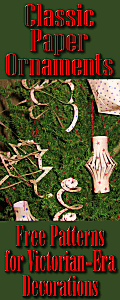

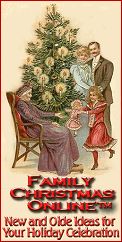



|


























 Many baby boomers remember their family building little communities around their nativity, Christmas tree, or train set at the holidays. Quite a few remember including inexpensive, glitter-sprinkled buildings made of pasteboard and imported from Japan.
Many baby boomers remember their family building little communities around their nativity, Christmas tree, or train set at the holidays. Quite a few remember including inexpensive, glitter-sprinkled buildings made of pasteboard and imported from Japan.

 Putz House Article on the "Christmas Notebook" Page - Blogger and crafter Rhonda C. has posted detailed photographs of her process for making a Christmas glitterhouse based on one of Howard Lamey's beach house patterns. If you have trouble visualizing exactly what it looks like to have the cardboard and everything laid out while you're working on it, this is a great resource. Thanks, Rhonda.
Putz House Article on the "Christmas Notebook" Page - Blogger and crafter Rhonda C. has posted detailed photographs of her process for making a Christmas glitterhouse based on one of Howard Lamey's beach house patterns. If you have trouble visualizing exactly what it looks like to have the cardboard and everything laid out while you're working on it, this is a great resource. Thanks, Rhonda.
 Putz House Patterns from the 1960s - After commercial cardboard Christmas houses got hard to find, Earth-friendly magazine Pack-O-Fun published free plans and instructions for making your own cardboard Christmas village from recycled materials. We put a little more detail into our articles today, but this gives you a good insite into the history of "build-your-own" putz houses.
Putz House Patterns from the 1960s - After commercial cardboard Christmas houses got hard to find, Earth-friendly magazine Pack-O-Fun published free plans and instructions for making your own cardboard Christmas village from recycled materials. We put a little more detail into our articles today, but this gives you a good insite into the history of "build-your-own" putz houses.
 Catherine Henry's Glitterhouses - The proprietor of the "Not Your Average Sock Monkey" blog has built several our glitterhouse designs, mostly with a few modifications you may find interesting. To see her December, 2009 blog on the subject, click on the photo to the right.
Catherine Henry's Glitterhouses - The proprietor of the "Not Your Average Sock Monkey" blog has built several our glitterhouse designs, mostly with a few modifications you may find interesting. To see her December, 2009 blog on the subject, click on the photo to the right.
















